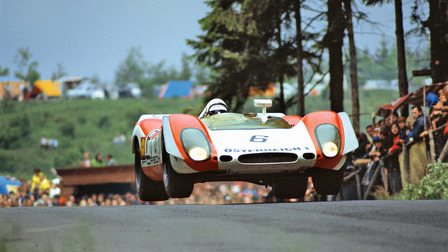
Where legends are made
It’s both revered and demonized. The Nürburgring elicits strong reactions like no other racetrack in the world. Opened on June 18, 1927, the track will turn ninety in just a few weeks. Many chapters of motorsports history have been written on the legendary Nordschleife of the Nürburgring.
1927
German Grand Prix on the Nürburgring, 1927: Award ceremony for Otto Merz in Stuttgart-Untertürkheim with Ferdinand
Ferdinand Porsche ’s act of will
Thirty days after the Nürburgring opens, the German Grand Prix is held before a crowd of eighty-five thousand spectators. After just under five hours and nearly five hundred kilometers, Mercedes sweeps the podium, led by Otto Merz, the thirty-eight-year-old son of a mechanic from Esslingen. It’s also a great victory for Ferdinand
Date: July 17, 1927
Winner: Otto Merz
Car: Mercedes-Benz Type S
Distance: Eighteen laps of 28.265 kilometers (Nordschleife and Südschleife; north and south loops)
Winner’s average speed: 101.8 km/h
1936
The start of a fast-paced race: In 1936 many Olympic athletes watch a breathtaking battle on the slightly modified Ring. Backup (right photo): Bernd Rosemeyer with his wife Elly Beinhorn (left) and Ferdinand
Wonder car with sixteen cylinders
The thirty-three percent incline has just been installed at the Karussell corner. The German Grand Prix is under the spell of the upcoming Olympic Games in Berlin. Olympic athletes—including the Indian hockey team and equestrians from Romania—as well as thirty thousand tourists arrive in the Eifel region by means of a car rally and twenty-three special trains. The race offers 220,000 spectators the chance to watch a duel between Mercedes and Auto Union, with Auto Union ultimately emerging victorious. Bernd Rosemeyer wins ahead of his teammate Hans Stuck. The win also means another major success for Ferdinand
Date: July 26, 1936
Winner: Bernd Rosemeyer
Car: Auto Union Typ C
Distance: Twenty-two laps of 22.810 km (Nordschleife)
Winner’s average speed: 131.6 km/h
1956
Triumph: Wolfgang Graf Berghe von Trips (left) and Umberto Maglioli (second from right) celebrate their class win. Quick stop (right photo): Umberto Maglioli fueling up his
Victory for the ages
The 1956 World Sportscar Championship is a showcase of some of the greatest drivers in history. Juan Manuel Fangio and Sir Stirling Moss are among the illustrious field itching to tackle the one thousand kilometers of the Nordschleife. More than seventy thousand fans come to watch the race and admire the numerous
Date: May 27, 1956
Winners (class S 1.5-liter): Wolfgang Graf Berghe von Trips, Umberto Maglioli
Car:
Distance: Forty-four laps of 22.810 kilometers (Nordschleife)
Average speed of overall winners: 129.8 km/h
1967
After the race: Udo Schütz and his winning No. 17 car.
One thousand kilometers forever
While Formula One is going through a rough patch in Germany six years after the death of Graf Berghe von Trips and twelve years after the withdrawal of Mercedes-Benz, a great age of sports-car races is beginning—with
Date: May 28, 1967
Winners: Udo Schütz, Joe Buzzetta
Car:
Distance: Forty-four laps of 22.810 km (Nordschleife)
Winners’ average speed: 145.5 km/h
1970
Countdown: Kurt Ahrens (left photo, middle) and Vic Elford, a few hours before their triumph.
Porsche wins the championship title
A one-thousand-kilometer race is an ever-reliable source of fascinating moments, as Richard Attwood’s “flying”
Date: May 31, 1970
Winners: Vic Elford, Kurt Ahrens
Car:
Distance: Forty-four laps of 22.810 km (Nordschleife)
Winners’ average speed: 165 km/h
1983
Wunderkind: Stefan Bellof drives the fastest lap in the history of the Nordschleife.
The fastest lap
47,376,000 minutes—that’s roughly how long ninety years last. If one were to reduce the nine-tenths of a century that the Nürburgring has been in existence down to a single race, it would last 6:11.13 minutes. That is precisely how long Stefan Bellof needs in training for the final one-thousand-kilometer race on the old Nürburgring on May 28, 1983. Due to construction on the new Ring, the lap circuit has been shortened—the drivers are starting from Döttinger Höhe. A lap is now 22.832 kilometers instead of 20.832 kilometers. Never before and never again does a driver lap the circuit at an average speed of over 200 km/h. No other driver dares to drive in such a rigidly tuned car with such a razor-thin margin of error at the limit. Too thin even for the wunderkind at times: the next day, his 485-kW
Date: May 28, 1983 (training), May 29, 1983 (race)
Winners: Jochen Mass / Jacky Ickx
Car:
Lap record: Stefan Bellof (6:11.13 min.)
Distance: Forty-four laps of 20.832 km (Nordschleife)
Winners’ average speed: 165 km/h
1993
Bumper to bumper: Less than a minute separates first-place winner Franz Konrad from the number two spot. Only on the podium do they come closer.
Close call
In 1993 the 24 Hours Nürburgring makes history twice: first, it’s the last time the DTM drives laps in the preliminary program on the Nordschleife; second, victory has never been such a close call. Driving a 911
Date: June 12 and 13, 1993
Winners: Franz Konrad, Frank Katthöfer, Örnulf Wirdheim, Antonio de Azevedo
Car:
2010
Historic: Not even a breakdown can keep the
22:15
In 2010
Date: May 15 and 16, 2010
Drivers: Jörg Bergmeister, Marco Holzer, Richard Lietz, Martin Ragginger
Car: 911 GT3 R Hybrid
2011
Spectacle: In typically rainy Eifel weather, one hundred drivers make
The greatest Porsche race
No one has seen the likes of this, not even at the Nürburgring: The
Date: June 25, 2011
Winner: René Rast
Distance: Six laps of 22.810 km (Nordschleife)
articipants: One hundred from twenty-five countries
Car:
2013
The
Tearing into the future
The Nürburgring: a legendary site of legendary feats, not only from decades past. A new legend is created on the day in late summer 2013 when
Date: September 4, 2013
Record: Marc Lieb
Car:
Average speed: 179.5 km/h
Testing the limits: Nürburgring’s legendary Nordschleife
As one of the first carmakers,
By Gerald Enzinger
Photos by Ferdi Kräling, Archiv
![[+]](https://files.porsche.com/filestore/image/multimedia/none/christophorus-issue381-article10-margin-01/normal/5b4b4ec3-19e4-11e7-9f74-0019999cd470/porsche-normal.jpg)
![[+]](https://files.porsche.com/filestore/image/multimedia/none/christophorus-issue381-article10-margin-02/normal/62423791-19e4-11e7-9f74-0019999cd470/porsche-normal.jpg)
![[+]](https://files.porsche.com/filestore/image/multimedia/none/christophorus-issue381-article10-margin-03/normal/76df8899-19e4-11e7-9f74-0019999cd470/porsche-normal.jpg)
![[+]](https://files.porsche.com/filestore/image/multimedia/none/christophorus-issue381-article10-margin-04/normal/7e88f8d2-19e4-11e7-9f74-0019999cd470/porsche-normal.jpg)
![[+]](https://files.porsche.com/filestore/image/multimedia/none/christophorus-issue381-article10-margin-05/normal/8e7b55a4-19e4-11e7-9f74-0019999cd470/porsche-normal.jpg)
![[+]](https://files.porsche.com/filestore/image/multimedia/none/christophorus-issue381-article10-margin-06/normal/c8fcc4c4-19f0-11e7-9f74-0019999cd470/porsche-normal.jpg)
![[+]](https://files.porsche.com/filestore/image/multimedia/none/christophorus-issue381-article10-margin-07/normal/e3627ee4-1ab6-11e7-9f74-0019999cd470/porsche-normal.jpg)
![[+]](https://files.porsche.com/filestore/image/multimedia/none/christophorus-issue381-article10-margin-08/normal/f026f4b8-19f0-11e7-9f74-0019999cd470/porsche-normal.jpg)
![[+]](https://files.porsche.com/filestore/image/multimedia/none/christophorus-issue381-article10-margin-09/normal/6b53ef17-19f1-11e7-9f74-0019999cd470/porsche-normal.jpg)
![[+]](https://files.porsche.com/filestore/image/multimedia/none/christophorus-issue381-article10-margin-10/normal/73c09062-19f1-11e7-9f74-0019999cd470/porsche-normal.jpg)
![[+]](https://files.porsche.com/filestore/image/multimedia/none/christophorus-issue381-article10-margin-11/normal/fe7f26dc-1ebe-11e7-9f74-0019999cd470/porsche-normal.jpg)









